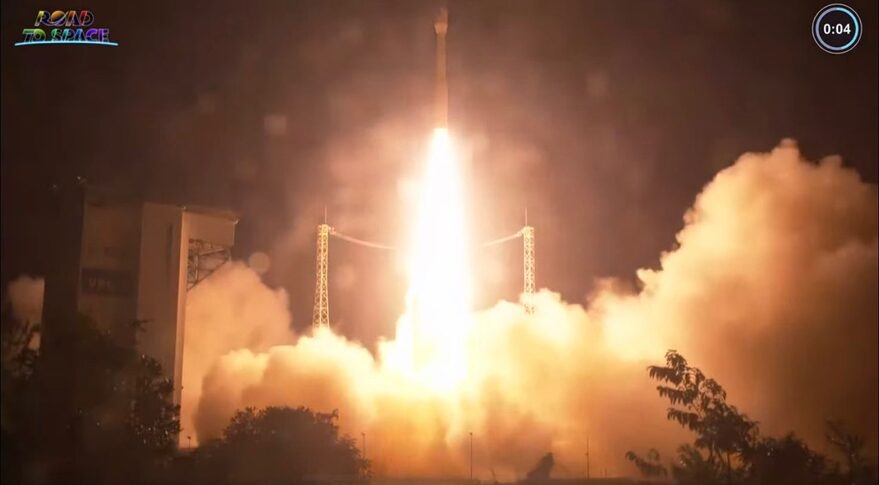
Independent panel to investigate Vega C launch failure (Image Credit: Space News)
WASHINGTON — Arianespace and the European Space Agency will establish an independent commission to investigate the Vega C launch failure Dec. 20 that resulted in the loss of two satellites and new questions about the future of European space access.
Arianespace and ESA announced Dec. 21 they will jointly create an independent inquiry commission to identify the cause of the launch failure and determine the steps needed to return the Vega C to flight. The committee will be chaired by ESA’s inspector general and Arianespace’s chief technical officer and be staffed with “independent experts,” the company and agency said.
In a short online presentation Dec. 21 — billed as a press conference but without taking any questions from media — officials provided a few additional details about the failure. Pierre-Yves Tissier, Arianespace’s chief technical officer, confirmed that the failure involved the Vega C’s second stage, a solid motor called the Zefiro-40 or Z-40. “The failure seems limited to the Z-40,” he said.
After a nominal burn by the rocket’s P120C first stage, the Zefiro-40 ignited and performed normally for seven seconds. “After seven seconds, we saw a progressive decrease of the chamber pressure up to 208 seconds” after liftoff, he said. At that point, “the pressure dropped down suddenly.” Several electronics units on the stage then failed, he said.
That matched tracking video shown during the launch webcast. At about three and a half minutes after liftoff, the plume from the engine changed appearance, brightening and expanding. Around that time the rocket began to diverge from its trajectory displayed on the webcast.
Tissier said that range safety shortly thereafter terminated the launch. The vehicle and its payload fell into the Atlantic Ocean out of harm’s way. “We have recovered all the data from the flight, so we are in position to analyze all these data,” he said.
Stefano Bianchi, head of flight programs at ESA’s space transportation directorate, confirmed the focus of the investigation will be on the Zefiro-40 stage. That motor is an upgraded version of the Zefiro-23 from the original Vega. The Zefiro-23 was blamed for a July 2019 Vega launch failure that destroyed a Falcon Eye imaging satellite for the UAE.
“The engine was qualified on the ground through two successful firing tests,” he said of the Zefiro-40, as well as the first, successful Vega C launch in July.
“In our capacity as the industrial prime contractor, first of all we take full charge of the responsibility for this Vega C failure,” said Giulio Ranzo, chief executive of Avio. Shares in the company, trading on the Borsa Italiana exchange, fell 9.5% in trading Dec. 21.
He said Avio and its suppliers would fully support the independent investigation into the failure and “follow rigorously the recommendations it will come up with to improve in a radical manner the flightworthiness of this new launcher.”
Neither Ranzo nor others at the presentation estimated how long the investigation and return-to-flight activities would take. After the July 2019 Vega launch failure, the vehicle was grounded for more than a year, returning to flight with a successful launch in September 2020.
The rocket’s next launch, in November 2020, failed because of incorrectly connected cables in the control system of the Avum upper stage. Vega returned to flight in April 2021.
The Vega C failure is another setback for Europe’s space access capabilities, which have also suffered from extensive delays in the development of the Ariane 6, whose first launch has slipped to late 2023, and withdrawal of the Soyuz rocket from French Guiana after Russia’s invasion of Ukraine in February.
Stéphane Israël, chief executive of Arianespace, noted at the presentation that the Vega problem does not affect either the Ariane 5 or Ariane 6. The Ariane 6 in particular uses the same P120C motor that powers Vega C’s first stage for its strap-on boosters, but the P120C worked as expected on the Vega launch. The Ariane 5 has no such link to the Vega C, but there are only two launches of that vehicle left, which are expected to take place in the first half of 2023.
“We are committed to organize and implement a long-lasting, successful return to flight of Vega C,” Israël said, but did not estimate how long that would take.








